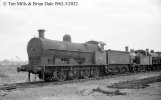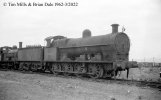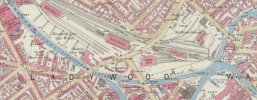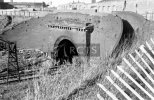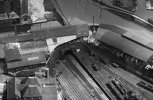Includes German Railways 1974
oldravendale
Western Thunderer
Excellent sleuthing there, Mick, and well done for getting the confirmation, Dave.
Roger, Michael and Dave - yes indeed - that 2-10-0 is a 2-8-2. I'm grateful that someone can count - well, everyone can count better than me! Also, Dave, for that reference about German locos. And the location/route details, Dave.
I'm grateful that someone can count - well, everyone can count better than me! Also, Dave, for that reference about German locos. And the location/route details, Dave.
Thanks for yours too, Paul. It's comments like yours that keep the enthusiasm going.
As for the buses, Dave - not three - more like 36.
Another on an unconfirmed date but probably March to May 1961 now confirmed as between May and August 1961. The view of the shed yard at Bescot with an 8F and Black 5 in evidence.

G2a 0-8-0 49078 in Bescot Shed Yard carrying a 21B Bescot shed plate on an unconfirmed date but in the series I've proposed as probably between March and May 1961 - but see below - now confirmed as between May and August 1961. There's a dispute between BR Database and SLS on this one as SLS reports it to have been transferred to Bescot from Nuneaton in May 1962 and that Bescot was its last shed. However, BR Database advises that the loco moved from Bletchley to Bescot in late April 1961 and back to Bletchley in January 1962 where it was withdrawn the following December. Rail UK agrees that Bletchley was the last shed and a withdrawal date of December. WHTS agrees with the withdrawal date. For me the confirmation that BR Database is probably correct is that my Locoshed Book for 1958 shows the loco allocated to Willesden (frustratingly I don't have one for 1961 to confirm the allocation at that time) with which BR Database agrees but the SLS record does not show any allocation to Willesden. WHTS and Rail UK advise it was scrapped at Loom Albert, Spondon (a new one on me which I've established is near Derby) by the end of November 1964.
The reason I've laboured this is that if the BR Database allocation date to Bescot is correct we can refine the date of these photos further, to being no earlier than May 1961. 41168 and 40692 in the posts #2889 and #2891 and in the same series of negatives left Monument Lane after storage for scrap in August which now puts this series of photos firmly in 1961 and probably between May and August.

Fortunately BR Database and SLS agree on this one although it gets us no nearer an accurate date. (Now confirmed as between May and August 1961). 2P 4-4-0 40694 in Bescot Yard with a 21B Bescot shed plate. It was allocated to Bescot in May 1960 and was withdrawn from there in November 1962 as the last of the class. It went to Crewe Works for disposal which was completed by the end of July 1963. I was hopeful that 40646 in the background may help with the dating but again BR Database and SLS broadly agree that the loco was transferred to Bescot in May 1960 and was withdrawn from there in May 1962, going to Cashmore's, Great Bridge where it was scrapped in September with which Rail UK and WHTS agree.
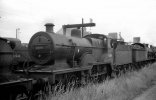
Now re-dating these photos to between May and August 1961 we have Midland 2F 0-6-0 58123 carrying a 21B Bescot shed plate with 58122 behind. 58123 arrived at Bescot on 1st April 1961 and was withdrawn from there in July 1962. (SLS and BR Database). It was scrapped at Derby Works at some time in 1962 (Rail UK and BR Database), although WHTS suggests it was scrapped at Cashmore's, Great Bridge with a query next to that data.
58122 arrived at Bescot in June 1958 and was withdrawn from there in September1961. (SLS). It was scrapped at Cashmore's Great Bridge in January 1962. (BR Database).
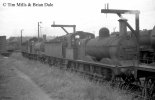
Just two from Germany today, still Rheine - Emden in March 1974 and now with oil burners 2-10-0 043 094-2 and Pacific 012 075-8 at an unidentified shed. More to come here so identification may ultimately be possible.
Edit:
The shed is Bw Rheine, home to most of the oil burners late in life.
The office building in the background is distinctive (with it's double window dormer), not unique I'm sure but the shed, turntable and sidings to the right all match BW Rheine.
I can confirm it is Bahnbetriebswerk (Bw) Rheine. The Ringlokschuppen is on the right behind the loco on the turntable.


Brian
Roger, Michael and Dave - yes indeed - that 2-10-0 is a 2-8-2.
 I'm grateful that someone can count - well, everyone can count better than me! Also, Dave, for that reference about German locos. And the location/route details, Dave.
I'm grateful that someone can count - well, everyone can count better than me! Also, Dave, for that reference about German locos. And the location/route details, Dave.Thanks for yours too, Paul. It's comments like yours that keep the enthusiasm going.
As for the buses, Dave - not three - more like 36.

Another on an unconfirmed date but probably March to May 1961 now confirmed as between May and August 1961. The view of the shed yard at Bescot with an 8F and Black 5 in evidence.

G2a 0-8-0 49078 in Bescot Shed Yard carrying a 21B Bescot shed plate on an unconfirmed date but in the series I've proposed as probably between March and May 1961 - but see below - now confirmed as between May and August 1961. There's a dispute between BR Database and SLS on this one as SLS reports it to have been transferred to Bescot from Nuneaton in May 1962 and that Bescot was its last shed. However, BR Database advises that the loco moved from Bletchley to Bescot in late April 1961 and back to Bletchley in January 1962 where it was withdrawn the following December. Rail UK agrees that Bletchley was the last shed and a withdrawal date of December. WHTS agrees with the withdrawal date. For me the confirmation that BR Database is probably correct is that my Locoshed Book for 1958 shows the loco allocated to Willesden (frustratingly I don't have one for 1961 to confirm the allocation at that time) with which BR Database agrees but the SLS record does not show any allocation to Willesden. WHTS and Rail UK advise it was scrapped at Loom Albert, Spondon (a new one on me which I've established is near Derby) by the end of November 1964.
The reason I've laboured this is that if the BR Database allocation date to Bescot is correct we can refine the date of these photos further, to being no earlier than May 1961. 41168 and 40692 in the posts #2889 and #2891 and in the same series of negatives left Monument Lane after storage for scrap in August which now puts this series of photos firmly in 1961 and probably between May and August.

Fortunately BR Database and SLS agree on this one although it gets us no nearer an accurate date. (Now confirmed as between May and August 1961). 2P 4-4-0 40694 in Bescot Yard with a 21B Bescot shed plate. It was allocated to Bescot in May 1960 and was withdrawn from there in November 1962 as the last of the class. It went to Crewe Works for disposal which was completed by the end of July 1963. I was hopeful that 40646 in the background may help with the dating but again BR Database and SLS broadly agree that the loco was transferred to Bescot in May 1960 and was withdrawn from there in May 1962, going to Cashmore's, Great Bridge where it was scrapped in September with which Rail UK and WHTS agree.

Now re-dating these photos to between May and August 1961 we have Midland 2F 0-6-0 58123 carrying a 21B Bescot shed plate with 58122 behind. 58123 arrived at Bescot on 1st April 1961 and was withdrawn from there in July 1962. (SLS and BR Database). It was scrapped at Derby Works at some time in 1962 (Rail UK and BR Database), although WHTS suggests it was scrapped at Cashmore's, Great Bridge with a query next to that data.
58122 arrived at Bescot in June 1958 and was withdrawn from there in September1961. (SLS). It was scrapped at Cashmore's Great Bridge in January 1962. (BR Database).

Just two from Germany today, still Rheine - Emden in March 1974 and now with oil burners 2-10-0 043 094-2 and Pacific 012 075-8 at an unidentified shed. More to come here so identification may ultimately be possible.
Edit:
The shed is Bw Rheine, home to most of the oil burners late in life.
The office building in the background is distinctive (with it's double window dormer), not unique I'm sure but the shed, turntable and sidings to the right all match BW Rheine.
I can confirm it is Bahnbetriebswerk (Bw) Rheine. The Ringlokschuppen is on the right behind the loco on the turntable.


Brian
Last edited:



